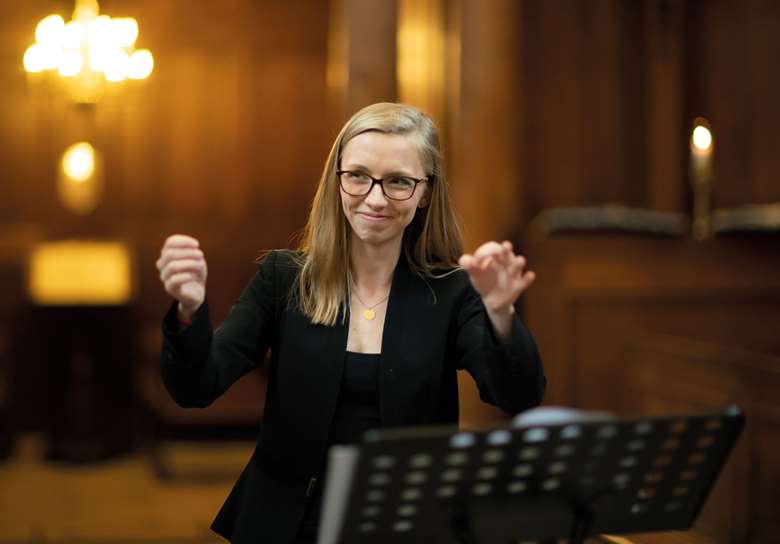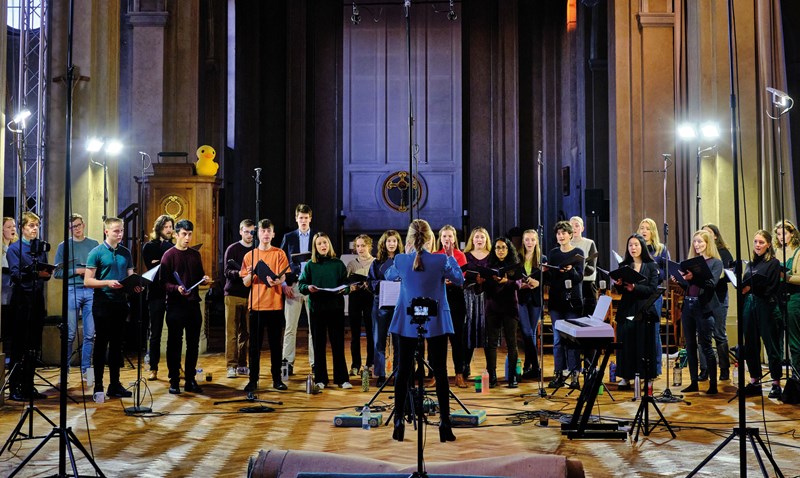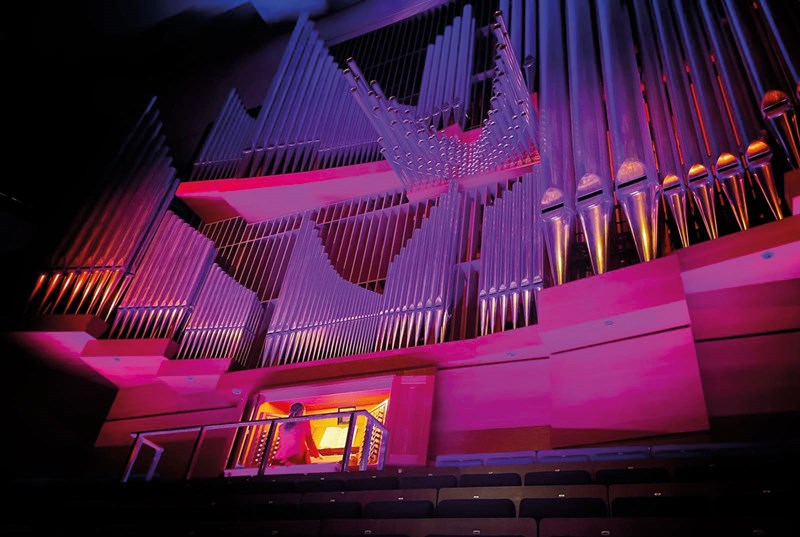Meeting Anna Lapwood, classical music's dream ambassador
Martin Cullingford
Thursday, August 18, 2022
Imaginative, open-minded and a brilliant musician, the organist and conductor Anna Lapwood is the dream ambassador for classical music. Martin Cullingford meets her

Anna Lapwood, Portrait No 1: the extraordinary amphitheatre of London’s Royal Albert Hall, epic yet enveloping, packed with dancers rhythmically responding to electronic dance music act Bonobo. There’s a dramatic pause in the beat, and, backed by an immersive light show, in comes the sound of the hall’s monumental organ, the towering pipes’ full-throated chords filling both the space and the hearts of the crowd.
Even watched on the small rectangle of my iPhone, it’s a magnificent moment. Perhaps every dance act should have an organ. Perhaps every organ recital should have a crowd of thousands of young people. And with someone as charismatic and open-minded as Anna Lapwood acting as an advocate for the art form, perhaps they might.
I’m guessing most readers here didn’t first encounter Lapwood at the RAH Bonobo concert, but rather through one of her recordings for Signum, either with the choirs she conducts at Pembroke College, Cambridge (where she was appointed Director of Music in 2016, aged just 21), or her solo organ album, ‘Images’, released last year; or maybe as a presenter, fronting the BBC Young Musician competition or a number of other shows; or, indeed, on social media, where she’s an active and imaginative user of the reach offered by Twitter – where I regularly encounter her postcards of everything from the arrival at a new recital venue to the Bonobo concert we began with – and TikTok, where I confess I rarely stray. Perhaps I should go there more often.
‘The potential to entice people and to bring them in is huge,’ Lapwood tells me as we meet for coffee in the stylishly gentrified area behind King’s Cross where coal yards have given way to cool cafes, and where Google is building a ‘landscraper’ longer than the Shard is tall. ‘I posted a video of me playing Saint-Saëns which got five million views’ – check notes, yes, she did say five million – ‘and that led to 90,000 people all just engaged with the organ, and asking questions like, “How do the pedals work?” “How do the stops work?”’

Recording at St George’s, Chesterton (spot the choir mascot) (photography: Hugh Warwick)
If all that feels a long way from the Christopher Wren-built chapel of Pembroke College, where traditions are traced in centuries, it both is, and isn’t – for in the hands of someone like Lapwood, choral music is a tradition that is very much alive, in the sense of evolving and being relevant to today. For a start, one of her two choirs is her own creation: a choir for girls, established to offer the opportunities that being a chorister can bring to those who have traditionally found them harder to obtain owing to their gender (something that is, thankfully, changing). It takes girls aged 11 to 18 from local schools – 60 per cent of them state schools – and sings one service a week, and several years since its foundation it already feels like a permanent part of the collegiate choral scene.
The membership of the other Pembroke choir is older, drawing on undergraduates (both men and women) and singing two services. On occasions both choirs come together for recording or performance. ‘Celestial Dawn’, this month’s new release, is a showcase of the Pembroke College Girls’ Choir in works by Wayne Marshall, Roxanna Panufnik, Eric Whitacre and other contemporary composers alongside pieces by Bach, Mendelssohn and Nadia Boulanger.
A video of me playing Saint-Saëns got five million views – and that led to 90,000 people all just engaged with the organ
You can also catch the choirs online, where services are streamed. While some neighbouring colleges have done this for a while, for Pembroke this was a pandemic development. ‘I remember when we were talking about getting streaming equipment for all our services because we couldn’t have congregations, and saying that I hated the idea, because choir should be a safe space where the girls can make their first mistakes,’ recalls Lapwood. ‘When we normally do Evensongs, there’s that moment when everyone holds their breath when a girl is doing her first solo – and you just think that making that moment completely public and available for everyone puts pressure on them in a slightly different way. But what’s been amazing is watching our perceptions of streaming change as we’ve become so used to it. It’s made us realise that mistakes are inevitable, and not something that we should get hung up on, and the girls (and their parents) have really appreciated having it recorded and streamed. If a singer isn’t pleased with how they’ve sung and asks for me to take it down, then I will (I think it’s really important to have that trust there), but I think streaming has changed our sense of “perfection” a little bit.
‘It’s the same conversation that we have about social media,’ Lapwood adds. ‘There’s a generation who think you should only put out the absolute best in what you’re doing, and there’s my generation who feel keener to show everything, including the bits that don’t quite go according to plan. And is a young person going to be more inspired by seeing someone who is totally perfect and seems to have no flaws, or by watching someone make mistakes and be honest about that?’
It reminds me of the countless conversations I’ve had over the years about the relative merits of the ‘perfection’ of a studio session versus off-air historic live recordings in which wrong notes are the trade-off for in-the-moment spontaneity.
‘If you’re always worrying about singing absolutely perfectly then I think there’s far less room for experimentation and taking risks. One of my favourite things to do with the choirs – particularly the Chapel Choir – is to choose something like James MacMillan’s O Radiant Dawn (which is a piece that is not particularly hard for them to sing, and which they know quite well), and then not tell them what dynamics we’re going to do – we’ll do it completely differently every time. And yes, it runs the risk that one person will come in forte when everyone else is pianissimo if they don’t watch, but actually that’s never happened and instead it means that they always sing in a really exciting, energised way, because they are making music in real time as opposed to “pressing play” on the rehearsed version they’ve done to death.’
Set against that, Lapwood also expresses her belief that music ‘is one of the few tools for encouraging positive perfectionism in young people. In schools there’s a little bit of a move away from perfectionism in some ways, and it actually can be a really positive process if you engage in it properly, and healthily, and in a nurturing environment.’ It is, as in the case of all acts of creativity, about finding a balance.
Anna Lapwood, Portrait No 2: St George’s Church, Chesterton, just outside Cambridge city centre, a few days earlier. I arrive after a tranquil walk along the river Cam on a glorious spring morning, rowers leaving arrows in their wake across the glistening water. Lapwood is conducting the combined choirs of Pembroke College who are recording their – ironically, given the weather – Christmas release: a programme of modern repertoire. Suburban, surprisingly cavernous and brick-built in the 1930s, the church offers a splendid acoustic and a quiet environment for recording. Or at least it should do. But with it being such a clear day, private pilots are buzzing around the sky taking in the exquisite cityscape. (At one point producer Adrian Peacock, closely monitoring a flight app, pauses proceedings. ‘There’s a Spitfire over Girton,’ he says, laconically, ‘and it’s heading this way.’ A minute later, the historic plane’s evocative engine can indeed be heard overhead.)
‘What I love is that now the choirs just assume everything is by a woman and I have to say, “No, this one is by a man!’”
The nave offers a slightly surreal scene. On one side of the church is a bank of circus equipment belonging to a group who rent the space (‘I remember, at one of the first sessions we did there, finding one of the basses up on a trapeze,’ recalls Lapwood); on the other side there’s a food bank; and in between, perched on the pulpit, there’s a giant inflatable duck. ‘That’s our choir mascot!’ Lapwood later tells me. ‘She’s called Anna Quackwood.’ It was bought by a previous organ scholar who thought he’d ordered a normal-size duck, and it now presides over all the choirs’ sessions.
It’s a nice reminder that for all the seriousness of music-making, levity and informality are rarely far away, offering a necessary release from the intensity of recording. We are, after all, talking about teenagers and young adults here, and aside from, say, Olympic skateboarding or gymnastics, there aren’t many areas where people so young stand alongside adults on such a stage of prominence and professionalism.

Anna Lapwood, playing the organ of Manchester's Bridgewater Hall (photography: Martin Stevens)
‘They’re really good at switching emotion on for a performance, whether that’s Evensong or a concert. They’re very good at getting to the emotional depth of a piece,’ says Lapwood. ‘But I think they find that much harder when they’re dotting in and out, and doing 16 bars a couple of times and getting it right and then moving on. It can turn into a bit of a note exercise, and I see it as my role as a conductor in a recording session to find ways almost to distract them from what we’re doing, to give them a bit of a reset so that they can go back in and engage emotionally in the same way.’ Reviving resonance is a part of this. One work I hear them record, Halcyon Days by Melissa Dunphy, has particular poignancy. The final piece sung at the end of an academic year, it was also the first sung on returning from Covid, and Lapwood asks the singers to remember what it felt like to be together again after the challenges of the pandemic. It works.
‘On the last album, “All Things Are Quite Silent”, we did Laura Mvula’s Sing to the Moon, and [composer and singer] Joanna Forbes L’Estrange came to work with them. She said, “You need to imagine your friend is in floods of tears and you’re trying to comfort them.” The choir got so into it that actually in the session they were crying – they can all relate to that. I found it an intensely emotional experience, and that came out on the recording – you hear not just the notes, but something slightly more.’
Something that’s come to define Pembroke’s choirs is their diversity of repertoire, with every service, concert or programme featuring at least one piece by a female or ethnic minority composer. But what now seems so intrinsic to their identity was initially something of an epiphany for Lapwood herself. ‘This started in my second year in my role. Sarah MacDonald – Director of Music at Selwyn College – gave me a spreadsheet of music by female composers, and I looked at my music list from the year before and realised there was not a single piece by a woman, just because the repertoire I’d grown up with didn’t include that music. I was absolutely horrified by myself, and so I said, just for a term, we would do a piece by a woman in every service. It went down really well.’
The experiment became permanent. ‘What I love is that now the choirs just assume everything is by a woman composer and I have to say, “No, this one is by a man!”’ It has also, Lapwood believes, led to singers having the courage to try their hand at composing. ‘The openness just to try things permeates through the wider atmosphere of the choir and gives people confidence, a safe space, so they can come to me and say, “I’ve written a piece, can we try it?” And we’ll give it a go, be constructive, and make it as good as possible.’
I ask Lapwood if she feels the diversity of the choirs’ repertoire helps to change wider perceptions about what choral music is, or could be. ‘I was talking to the singers about Henry Burleigh; we recorded his O Perfect Love and I was explaining that he was the leading African American songwriter, and one of the girls very proudly said, “We’re so woke!” – and she was thrilled about this. I know that can be used as an insult, but for them it’s something that they see as really positive. I really feel for children in choirs where they’re not doing this, because I don’t think they realise that they’re missing out on a huge world of repertoire that is amazing and really engaging.’
This leads us from the choir stalls over to the organ bench, the other side of Lapwood’s life. ‘I really want to record the complete organ works of Florence Price,’ she says. ‘It began as a little lockdown thing. For Women’s History Month last year I decided to post a video of myself playing a piece by a woman every single day, so it meant I was learning loads of new music. I discovered that Price had written five volumes of organ music – a huge body of music, with some incredible pieces. Some of them are little, very beautiful, well-constructed pieces that work before and after services. But then she also wrote a Passacaglia and Fugue, an Organ Sonata, a Suite – some really substantial music. I really want to get it recorded so that other people might realise how good it is.’ The task is helped – and made more fascinating still – by the fact that each volume begins with an essay giving details of every single organ that Price played, complete with stop lists.
More mainstream ambitions include the Poulenc Concerto, and possibly the Saint-Saëns Organ Symphony too. But another unusual highlight for Lapwood and listeners alike was her transcription of the Four Sea Interludes from Peter Grimes which appeared on ‘Images’. She exploited the colour and acoustics of the organ, and in particular the magisterial instrument of Ely Cathedral, to recast Britten’s atmospheric evocation of the Suffolk sea in a striking new light.
Back at Pembroke, Lapwood has been tweaking the nature of some of the services to attract more students – particularly Compline, which I know as a small, intimate but somewhat niche twilight office. ‘We always do a sacred and secular piece, and we use it as an opportunity to look at some of the accessible contemporary music people might recognise from other areas in their life. And we host drinks afterwards for everyone. The first time we did it like that we went from having no one (literally no one) at Compline, to having 100 students. It tends now to be about 30. Why the appeal? I think it’s that it’s so anonymous. The students can come and sit and be totally still and quiet, and not do anything for half an hour – and when they’re students at Cambridge and they’re asked to do something basically every hour of every day, that’s quite a powerful thing.’
Anna Lapwood, Portrait No 3: this time aged around 14 – the same as some of the girls in the ranks of one of her choirs today. As she confides over our King’s Cross coffee, the young Lapwood was set on being a film composer. ‘I was obsessed with the music of Hans Zimmer. I remember hearing the Da Vinci Code soundtrack for the first time, and there’s an amazing track on it, “Chevaliers de Sangreal”, and I couldn’t get my head round how he’d created such amazing tension through something that sounds quite repetitive. I got some manuscript paper, and under the cover of night with a torch wrote down the chord progression and sat there with my mind being blown.’
Ambition, openness and an uninhibited enthusiasm for music-making in whatever form, from whatever source, known, unknown and new – so much of the Anna Lapwood of 2022 was already there. It’s remarkable to reflect that the teenager just described is not actually much more than a decade removed from the artist I’m interviewing today. Goodness knows what we’ll be talking about a decade hence. I can’t wait to find out.
Read the review: Lapwood and Pembroke College Girls’ Choir’s ‘Celestial Dawn’
This interview originally appeared in the August 2022 issue of Gramophone. Never miss an issue – subscribe today








